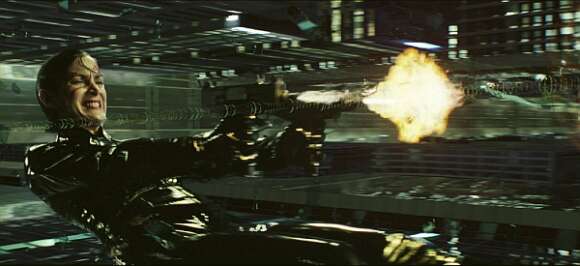“The Leung and the Restless”
 The 1980’s were the Golden Era for action heroines in Hong Kong cinema. Names like Cynthia Khan (a.k.a. Cynthia Yeoh), Michelle Khan, Yukari Oshima, Cynthia Rothrock and Moon Lee all came to prominence in the decade. Just sliding in before the bubble burst was Jade Leung, who came out of nowhere to win Best Newcomer at the Hong Kong Film Awards for her performance in 1991’s Black Cat. Jade was born in the then-British colony, November 23rd 1969, but spent four of her later teenage years in Switzerland, where she studied fashion and learned French. In 1990, she returned to Hong Kong and was one of 200+ actresses to audition for Steven Shin, director of Black Cat. She won out, despite her lack of experience, and underwent a rigorous training program to get in shape for the movie.
The 1980’s were the Golden Era for action heroines in Hong Kong cinema. Names like Cynthia Khan (a.k.a. Cynthia Yeoh), Michelle Khan, Yukari Oshima, Cynthia Rothrock and Moon Lee all came to prominence in the decade. Just sliding in before the bubble burst was Jade Leung, who came out of nowhere to win Best Newcomer at the Hong Kong Film Awards for her performance in 1991’s Black Cat. Jade was born in the then-British colony, November 23rd 1969, but spent four of her later teenage years in Switzerland, where she studied fashion and learned French. In 1990, she returned to Hong Kong and was one of 200+ actresses to audition for Steven Shin, director of Black Cat. She won out, despite her lack of experience, and underwent a rigorous training program to get in shape for the movie.
Its success, particularly in international markets (when shown as part of a series at the National Film Theatre in London, it pulled a bigger crowd than Drunken Master 2) lead to her being signed to a long-term deal by D&B Films. Unfortunately, the studio wasn’t around long enough to fulfill its end of the bargain, and Jade has been bouncing around, in search of adequate roles ever since. She hasn’t always been successful, saying of Fox Hunter, “There is no sense whatsoever to the movie’s content… It was also the most arduous, most painful movie I have done.”
Mind you, unbiased observers would likely point to Enemy Shadow in that category – during the filming of that one, Jade was badly burnt when a stunt went wrong. “When I opened my eyes, I was enveloped by blistering flames. During that moment, many questions that I had never thought of before flashed across my mind, there was a thin fine line between life and death. Afterwards, remembering that the camera was rolling in front of me, they were waiting for me to dart out to conclude the day’s work, I ignored everything and made a dash.” The near-fatal accident can still be seen in the movie.
While most of her contemporaries have since left the industry – for example, Moon Lee now runs a well-respected dance studio – Jade Leung continues to make films. She has also appeared in TV dramas, such as Battle Against Evil, and written a diet book, though as titles like 2000’s Black Cat in Jail or last year’s Black Cat Agent Files suggest, she has to some extent never escaped her most famous role. Jade has never achieved the international renown of Michelle Yeoh, and remains little known outside her native land. As we’ll see, this is perhaps unsurprising, because her filmography struggles to get past mediocre, and she has largely dead-ended in low-budget quickies. Yet, as one of the few remaining active action heroines working in Hong Kong, she probably deserves more respect and coverage than she has so far received. Here’s a look at some of the entries in her filmography.
Black Cat
By Jim McLennan★★★½
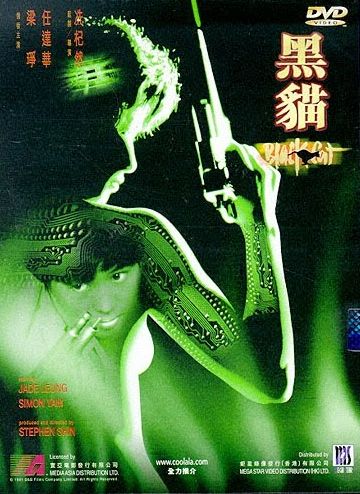 Before the official remake of Nikita came out, Hong Kong had already delivered its take on the matter. The film starts in New York, and a large part of this is in English, though the acting there is so woeful as to make you lean towards the Chinese dubbed version. The heroine, Erica, is made more sympathetic: while she still kills a cop, she’s not a junkie, and is “shot” while trying to escape. She wakes up under the watchful eye of Simon Yam, in the “Uncle Bob” role (though here, he’s a ‘cousin’).
Before the official remake of Nikita came out, Hong Kong had already delivered its take on the matter. The film starts in New York, and a large part of this is in English, though the acting there is so woeful as to make you lean towards the Chinese dubbed version. The heroine, Erica, is made more sympathetic: while she still kills a cop, she’s not a junkie, and is “shot” while trying to escape. She wakes up under the watchful eye of Simon Yam, in the “Uncle Bob” role (though here, he’s a ‘cousin’).
From here, the plot is similar to Nikita – missions, qualms, romance, escape attempt, etc – and interestingly, her boyfriend (Thomas Lam) is a photographer, an idea also used in the later Point. There are, however, significant differences in the details. For example, Erica has a chip implanted in her brain, supposedly, to help her achieve her full potential, but all it seems to do is give her raging headaches [admittedly, a potentially useful control mechanism]. They also skip the etiquette lessons, which seemed irrelevant to me anyway – how do good table manners help, when your mission solely involves the use of a sniper rifle?
The specifics of her missions are also altered. The final test, rather than an assassination in a restaurant, is to kill the bride at a Jewish wedding, for reasons left unexplained – but given the heavy weaponry carried by a lot of guests, it’s perhaps no bad thing! Others involve shooting an executive of the WWF (the nature group, not the wrestling federation!), a throat-slitting at a Japanese hot spring resort, and, in the best-staged sequence, dropping a lot of metal from a great height onto the roof of her target.
However, the movie’s main strength is Jade Leung, who fully deserved the Best Newcomer award she won at the 11th Hong Kong Film Awards. Every facet of her character is consistent and believable, certainly more so than Bridget Fonda – it’s at least the equal of Anne Parillaud, and arguably may be even better. Yam is perhaps a kinder, gentler handler: he doesn’t shoot his protege in the leg, for example, yet the relationship between them is missing the romantic spark which lurked in the original. As for Thomas Lam, he’s not Dermot Mulroney, and that alone is an improvement.
The film is undeniably flawed, not least in a soundtrack that is often wildly inappropriate, and seems to have been pulled at random from easy-listening CDs. But its core is solid, and in a lot of ways, this is a more justifiable movie than Point of No Return. While the story remains the same, Black Cat does at least bring a bottle to the party, adding enough new twists to make it interesting (and avoid a lawsuit). Leung’s fine performance is an unexpected bonus.
Dir: Stephen Shin
Star: Jade Leung, Simon Yam, Thomas Lam
Black Cat 2: The Assassination of President Yeltsin
By Jim McLennan★★★
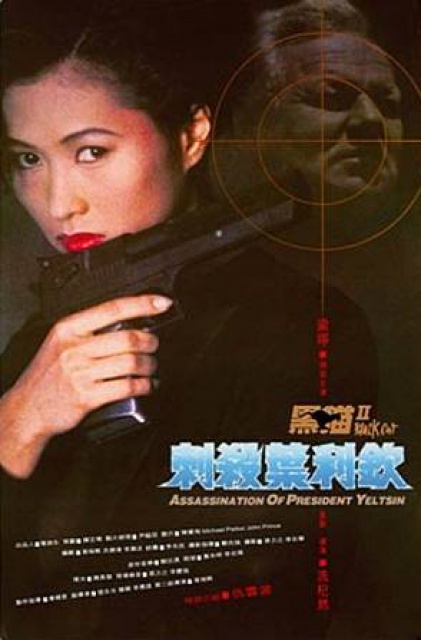 While neither Nikita nor The Assassin ever resulted in a sequel, the success of Black Cat lead, immediately to a follow-up. This is both good, in that it forced D&B Films into coming up with some new concepts, and bad, because what they came up with is a barely coherent mess. They take Leung – who had won the ‘Best Newcomer’ award – and give her a role where she gets to speak twice. The real star is Robin Shou, well before his Mortal Kombat days, and with a much better haircut too.
While neither Nikita nor The Assassin ever resulted in a sequel, the success of Black Cat lead, immediately to a follow-up. This is both good, in that it forced D&B Films into coming up with some new concepts, and bad, because what they came up with is a barely coherent mess. They take Leung – who had won the ‘Best Newcomer’ award – and give her a role where she gets to speak twice. The real star is Robin Shou, well before his Mortal Kombat days, and with a much better haircut too.
He plays a CIA operative – the laserdisk subs say this stands for Central Intelligent Agency, clearly dating this before 9/11 – who is investigating a group out to assassinate President Yeltsin. Their chosen hitman has been beefed up with some kind of ill-explained technological wizardry, but luckily, one person can detect the radiation he gives off: Black Cat, who now has a chip in her head (to match the one on her shoulder, hohoho). This leads to an amusing sequence where Black Cat heads off on her own, charges into a mall, and shoots an old lady because – wouldn’t you know it? – the senior citizen just happens to be giving off the same kind of radiation, courtesy of her medical treatment. Well, I found it amusing, anyway; there’s something about a head-shot which spatters the face of a nearby clown with copious amounts of blood. Er, just me, then? :-)
Okay, the movie may never be dull, and is certainly not short on action. Yet it doesn’t make any sense. Why would the CIA send operatives into Russia to save their president? And what are they doing operating in America? Isn’t that illegal? Oh, I forgot – it’s the CIA we’re talking about here. Leung’s robotic performance – even though entirely appropriate, since she now comes with an remote-control off switch – also feels like a terrible waste of her talents. There’s a lot of wire-work in the action sequences, but it’s not badly done; the highlight is probably a fight in a steel-works where both Robin and Jade have to take on large numbers of adversaries. The final battle, when Black Cat fights the assassin around the wreckage of a crashed plane, is cool too, with the two antagonists bouncing off the debris.
However, the overall impact is bitty and sporadic. While there are some nice ideas, they are poorly thought-out and developed, and the script doesn’t meld them into any kind of satisfactory structure. The action sequences feel equally bolted-on, though I did like the use of a President Yeltsin lookalike (at least, one presumes it was a lookalike, though I recall the real ex-President Gorbachev did appear in a Wim Wenders film). After the critical acclaim that greeted her debut, Jade Leung could have turned her skills in any direction; unfortunately, this disappointing follow-up is largely symptomatic of the poor choices that seem to have dogged her subsequent career.
Dir: Stephen Shin
Stars: Robin Shou, Jade Leung, Zoltan Buday, Patrick Stark
Satin Steel
By Jim McLennan★★★½
This fast, furious, largely daft movie was Jade’s immediate follow up to the two Black Cat films. If they were based on Nikita, the inspiration here is clearly Lethal Weapon, with Leung as a headstrong cop (also named Jade Leung!) who believes in shooting first and asking questions…oh, somewhere between eventually and never. With her sensible partner (Lee), she chases evil weapons broker Mr. Fowler and his gang from Singapore to Indonesia. It eventually ends above a volcano, with Jade clinging desperately to a helicopter.
The elements here are hugely variable: Leung and Lee have great chemistry, but Lee’s boyfriend Paul (Chan) may be the most irritating bastard in cinema history – his every appearance provoked a strong desire to throw things at the TV, and we cheered loudly when he was gunned down, particularly since it shut him up for a bit. In contrast Russell Wong is more sympathetic as Fowler’s naive lawyer, though since we know what happened to Jade’s first husband, this relationship might as well be wearing a sweatshirt marked ‘Doomed’. One also wonders why an international arms dealer would employ a troupe of native dancers as henchmen.
While the plot and characterisation leaves a little to be desired in originality and execution, the action is plentiful and energetic. Of particular note is the previously-mentioned helicopter sequence – at first, we suspected heavy stunt doubling, but later on, there are a couple of shots which give pause for thought, and Jade deserves greater credit. It’s just a shame it ends so abruptly. Jade’s battle against the dancers is also pretty cool, and Lee has a good fight at a train station, culminating with a leap in front of an oncoming engine that merited an immediate rewind and rewatch.
There is, however, something obviously cheap and apparently rushed about the whole endeavour, and it feels like one of the later entries in Cynthia Khan’s filmography – particularly, Angel on Fire, which also had two policewomen from different lands, travelling to a third (and presumably, cheaper to film in!) country to find the villains. One suspects Jade was under pressure to make another movie while her star was still rising, regardless of the end product’s quality.
Dir: Tony Leung Siu-Hung
Stars: Jade Leung, Anita Lee, Russell Wong, Kenneth Chan
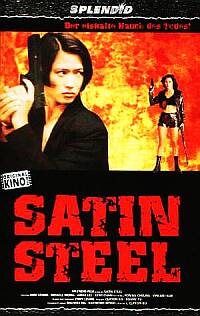 |
 |
 |
Velvet Gloves
By Jim McLennan★½
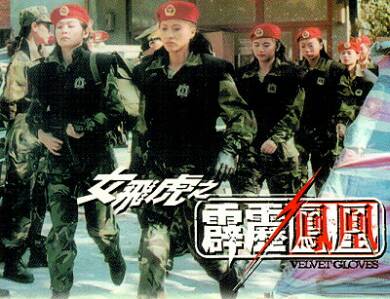 This film is a 90-minute explanation of why Jade Leung’s star never took off. While some decisions Michelle Yeoh made might have been questionable, at least her films were rarely boring, and never down to the level of this piece of tedious dreck. It depicts the struggles of a class of policewomen (including Jade), to become part of the elite. The idea certainly has potential – the Inspector Wears Skirts series has a similar premise – but here, there is almost no character given to any of the girls; they all blur into each other, like a dozen GI Jane-wannabes.
This film is a 90-minute explanation of why Jade Leung’s star never took off. While some decisions Michelle Yeoh made might have been questionable, at least her films were rarely boring, and never down to the level of this piece of tedious dreck. It depicts the struggles of a class of policewomen (including Jade), to become part of the elite. The idea certainly has potential – the Inspector Wears Skirts series has a similar premise – but here, there is almost no character given to any of the girls; they all blur into each other, like a dozen GI Jane-wannabes.
The director – whoever they may be, since the credits were all in Chinese, and the Internet offers limited assistance either – also seems to believe that if two minutes of the ladies taking on an assault course is good, ten minutes must be better. Another example is the seven-day forced march, which feels like it was filmed in real time, and screws up the most obvious opportunity for tension. It does lead to a somewhat interesting sequence, where three of the women have to last two minutes fighting martial-arts instructors, to avoid getting kicked out. But there is no flow to the plot at all – it lurches from set-piece to set-piece without cohesion or progression. All of which would be tolerable if the action elements weren’t handled in such a lacklustre fashion, but there’s nothing here to write home about, except in a “PS. Obvious stunt doubling” kind of way.
For some strange reason, this film appears to be unavailable on DVD – should you want to see it (and if you do, I’ve clearly failed in my mission here), you’ll have to see the VCD, with its illegible subtitles and a plot synopsis which shakes hands and parts company with the truth after the first sentence. It opts to visit the land of Wild Fabrication instead, continuing: “Before graduation, the team is called to handle a hostage situation in a jewelry expo. Afterwards the girls are assigned to as the bodyguard of the first lady of a small country. But the first lady’s own rebellious guard kidnaps her and executes one of the girls…” There’s not a single word of truth there: the movie finishes – abruptly – on graduation day, after yet another training mission.
But if you know what film that synopsis actually describes, do let me know, because it’s almost certainly far more interesting and entertaining than this one. It may not be the worst action heroine film I’ve ever seen, but it’s probably the worst ever to come out of Hong Kong, which usually does such things with a certain degree of invention, enthusiasm and energy. None of these are visible here, in any amount.
Dir: Billy Chan Wui-Ngai
Stars: Jade Leung, Bobby Au, Farini Cheung, Zhang Fengyi
Fox Hunter
By Jim McLennan★★★½
“For Fox’s sake…”
 Grittily disturbing, only some misplaced and failed stabs at comedy prevent this from likely being Leung’s best work ever. She plays rookie Hong Kong cop Jenny, following in the footsteps of her late father, who takes on an undercover mission aimed at trapping gangster Tung (Fung). While it succeeds, Tung escapes, and takes vengeance on Jenny, killing her uncle in brutal fashion. This, in turn, pushes her over the edge, and she teams up with his pimp-turned-informant (Chan), who is feeling aggrieved after having not received his promised reward from the authorities. The pair head to China, where Tung is hiding out, only for Jenny to rapidly wear out her welcome with the local cops and their commander (Guang). Worse is to follow, when Tung finds out they are on his tail, he begins a campaign of terrorism, culminating in wiring an entire shopping mall with explosives. He’s very fond of explosives…
Grittily disturbing, only some misplaced and failed stabs at comedy prevent this from likely being Leung’s best work ever. She plays rookie Hong Kong cop Jenny, following in the footsteps of her late father, who takes on an undercover mission aimed at trapping gangster Tung (Fung). While it succeeds, Tung escapes, and takes vengeance on Jenny, killing her uncle in brutal fashion. This, in turn, pushes her over the edge, and she teams up with his pimp-turned-informant (Chan), who is feeling aggrieved after having not received his promised reward from the authorities. The pair head to China, where Tung is hiding out, only for Jenny to rapidly wear out her welcome with the local cops and their commander (Guang). Worse is to follow, when Tung finds out they are on his tail, he begins a campaign of terrorism, culminating in wiring an entire shopping mall with explosives. He’s very fond of explosives…
The cover (right) is surely among the least accurate I’ve seen, depicting a frothy concoction mercifully not present – and the movie contains absolutely no pineapples at all, in case you were wondering. In particular, they really shouldn’t have tried to make Chan’s character any kind of comedic foil, because it just doesn’t work. During the early going, I was praying for his rapid, painful demise, though he does become more sympathetic in the second half. Fortunately, the other aspects outweigh the ill-considered negatives. Though this is one of only four films directed by Tung Wai (including an all time HK favorite, Magic Cop), he has a long pedigree as an action director – among his works previously covered here are Mulan, Reign of Assassins and The Assassin – and that’s when this movie shines. Particular standouts are a sequence in which Tung shows up at the apartment complex where our pair are hiding out, and the final battle up and down the insides of the mall.
It’s clear throughout that Leung is doing most, if not all, her own stunts; the sequence where she uses a sofa to escape a grenade blast is so realistic, you can virtually smell her singed eyebrows. It also helps that she isn’t portrayed as all at some kind of superwoman. Indeed, Tung is depicted as stronger, and far more brutal than the heroine, resulting in a genuine sense of peril for her – Jenny has to dig deep into her reservoir of tenacity simply in order to survive his onslaught, never mind prevailing over her nemesis. As well as the cover, the English-language title doesn’t do this justice, conjuring up a rather different set of images. While I get the sense of her going after a predator, something like Wolf Hunter might have been more appropriate, in terms of getting the hard-edged tone for which this aims.
Dir: Stephen Tung Wai
Star: Jade Leung, Jordan Chan, Ching Fung, Yu Rong Guang
See also: 1992 interview with Jade Leung, taken from Eastern Heroes.






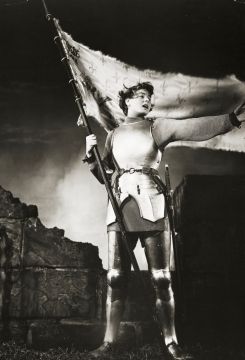

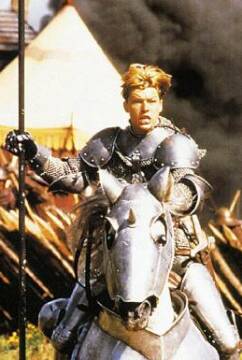
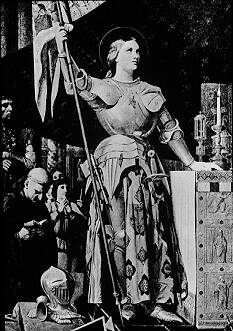 Born in the French province of Champagne in 1412, to a peasant farmer, Joan (or Jeanne – I’ll largely stick to the Anglicization) never learned to read or write, but was regarded by her contemporaries as a highly pious child. It was at the age of 13 that she first heard voices, but it took several years before they convinced her to leave home and help the French king, who was engaged in a battle to liberate the country from England. She presented herself to the local commander, who was skeptical at first, but was eventually convinced after Joan reported news of an English defeat before official confirmation arrived. Joan, clad in male attire to protect her modesty, travelled to see the king, and convinced him of the legitimacy of his claim to the throne, despite a faction of the court strongly opposing her influence. Her faith, simplicity and honesty won the day, and she acquired her sword, found buried behind an altar, in the exact spot she said it would be.
Born in the French province of Champagne in 1412, to a peasant farmer, Joan (or Jeanne – I’ll largely stick to the Anglicization) never learned to read or write, but was regarded by her contemporaries as a highly pious child. It was at the age of 13 that she first heard voices, but it took several years before they convinced her to leave home and help the French king, who was engaged in a battle to liberate the country from England. She presented herself to the local commander, who was skeptical at first, but was eventually convinced after Joan reported news of an English defeat before official confirmation arrived. Joan, clad in male attire to protect her modesty, travelled to see the king, and convinced him of the legitimacy of his claim to the throne, despite a faction of the court strongly opposing her influence. Her faith, simplicity and honesty won the day, and she acquired her sword, found buried behind an altar, in the exact spot she said it would be.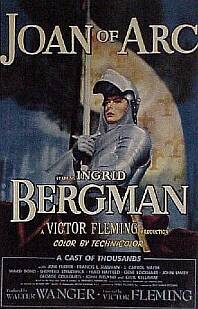 This was nothing more than a show trial, despite the efforts of those in charge to find support: according to biographer Jules Michelet, one jurist said “that everything about the trial was wrong; that it failed to respect the proper forms; that the assessors were not free; that the sessions were held in secrecy; that the accused…could not be expected to argue with learned doctors” and finished by declaring that it “was a trial to impugn the honour of the prince whose cause this girl is supporting; you should frankly say so.” Perhaps wisely, the holder of these opinions opted to leave France immediately for the safety of Rome.
This was nothing more than a show trial, despite the efforts of those in charge to find support: according to biographer Jules Michelet, one jurist said “that everything about the trial was wrong; that it failed to respect the proper forms; that the assessors were not free; that the sessions were held in secrecy; that the accused…could not be expected to argue with learned doctors” and finished by declaring that it “was a trial to impugn the honour of the prince whose cause this girl is supporting; you should frankly say so.” Perhaps wisely, the holder of these opinions opted to leave France immediately for the safety of Rome.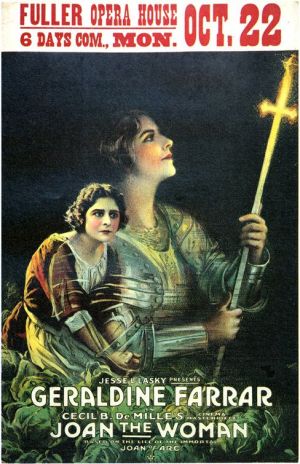 I don’t watch many silent films: it’s such an entirely different experience, obviously, much less driven by dialogue and more by gestures, leading to a style that can look extremely over-theatrical to the modern viewer. My efforts to enjoy the likes of Nosferatu, for example, have usually ended in my providing an accompaniment of snoring, to be honest. This was much better. Despite a running time of over two hours, this 1916 DeMille epic successfully held my interest, as it told the story of Joan of Arc. The framing device uses the then-contemporary World War I, and an English soldier (Reid) finds Joan’s sword in the trenches, the night before a dangerous mission [Interesting how the English are the enemy in the back-story, but the good guys “now” – at the time of release, America was still several months from entering the war, on the British side]. He then experiences a flashback vision, taking him to medieval France, where he is an English soldier saved by Joan (Farrar) in her milkmaid days. We follow her for the story you know, becoming the inspiration for the French army to defeat the English, before her capture, trial for heresy and – I trust I’m not spoiling this – burning at the stake.
I don’t watch many silent films: it’s such an entirely different experience, obviously, much less driven by dialogue and more by gestures, leading to a style that can look extremely over-theatrical to the modern viewer. My efforts to enjoy the likes of Nosferatu, for example, have usually ended in my providing an accompaniment of snoring, to be honest. This was much better. Despite a running time of over two hours, this 1916 DeMille epic successfully held my interest, as it told the story of Joan of Arc. The framing device uses the then-contemporary World War I, and an English soldier (Reid) finds Joan’s sword in the trenches, the night before a dangerous mission [Interesting how the English are the enemy in the back-story, but the good guys “now” – at the time of release, America was still several months from entering the war, on the British side]. He then experiences a flashback vision, taking him to medieval France, where he is an English soldier saved by Joan (Farrar) in her milkmaid days. We follow her for the story you know, becoming the inspiration for the French army to defeat the English, before her capture, trial for heresy and – I trust I’m not spoiling this – burning at the stake.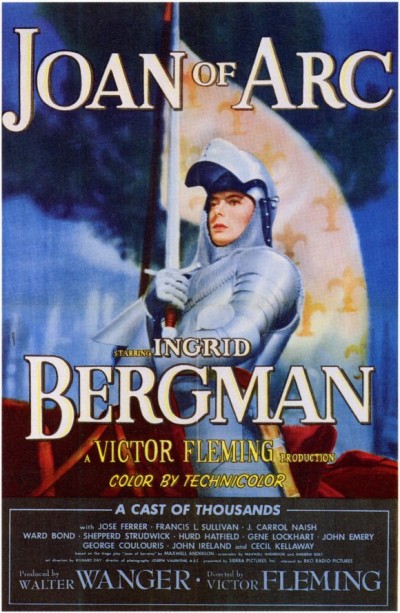 This film’s origins as a stage play are painfully apparent, and you can also see why the distributor’s felt it needed to have 45 minutes cut out before it could be released, as frankly, it’s a bit of a bore. The battle to recapture Orleans is the only action of note here, even though that represented the start of the Maid’s campaign to restore France to its proper ruler (Ferrer), rather than the end. After that, this more or less skips forward to his coronation, then Joan’s capture, spending the rest of the movie – and there’s a lot of it – going through the trial, and the railroading of the heroine into, first throwing herself on the church’s mercy, then recanting her recantation and returning to wearing men’s clothes, thereby sealing her fate. There’s not much here which you won’t have seen before, if you’ve seen any of the other versions of the story, touching the usual bases from Joan’s revelations that she’s going to be the saviour of France, through her trip to see the Dauphin, and so on. It does downplay the “voices” aspect, especially early on, perhaps a wise move since it’s difficult to depict, without making her seem like a religious fruitcake.
This film’s origins as a stage play are painfully apparent, and you can also see why the distributor’s felt it needed to have 45 minutes cut out before it could be released, as frankly, it’s a bit of a bore. The battle to recapture Orleans is the only action of note here, even though that represented the start of the Maid’s campaign to restore France to its proper ruler (Ferrer), rather than the end. After that, this more or less skips forward to his coronation, then Joan’s capture, spending the rest of the movie – and there’s a lot of it – going through the trial, and the railroading of the heroine into, first throwing herself on the church’s mercy, then recanting her recantation and returning to wearing men’s clothes, thereby sealing her fate. There’s not much here which you won’t have seen before, if you’ve seen any of the other versions of the story, touching the usual bases from Joan’s revelations that she’s going to be the saviour of France, through her trip to see the Dauphin, and so on. It does downplay the “voices” aspect, especially early on, perhaps a wise move since it’s difficult to depict, without making her seem like a religious fruitcake.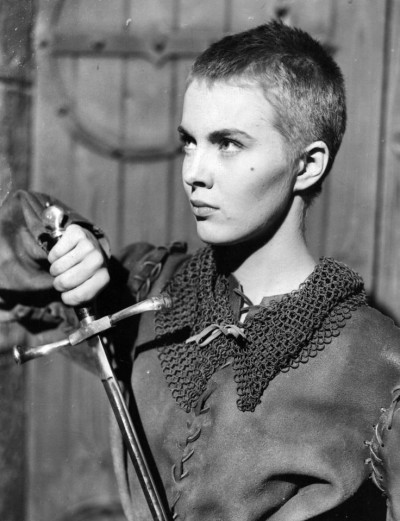
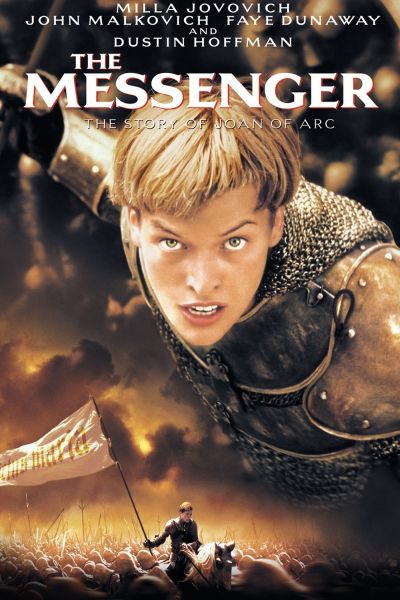
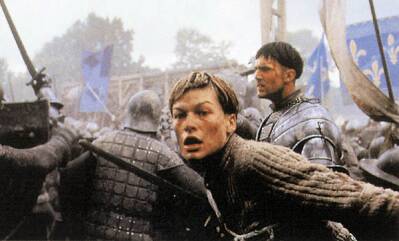 Joan’s capture, trial and execution are fairly close to the truth, though in reality, the King was less involved and more concerned for Joan than shown. It certainly is reasonable to suggest that a naive innocent such as Joan would have been used for political ends. Once she’d outlasted her usefulness – and with the king on the throne, she quickly became more a hindrance than a help – she would have needed to be disposed of. Must confess, I quite like the concept of Joan as a medieval version of Lee Harvey Oswald. Dustin Hoffman’s appearance as Joan’s conscience is another neat touch, and his sarcasm works well. Indeed, the film is one good performance from being excellent. The bad news is, it’s Jovovich who is the culprit (a messenger who deserves to be shot?), though Besson and co-writer Andrew Birkin perhaps warrant most of the criticism for twisting facts and characters in order to fit a predetermined goal. Their Joan is so far from the historical record, they’d have been better off placing their character in an entirely fictitious setting.
Joan’s capture, trial and execution are fairly close to the truth, though in reality, the King was less involved and more concerned for Joan than shown. It certainly is reasonable to suggest that a naive innocent such as Joan would have been used for political ends. Once she’d outlasted her usefulness – and with the king on the throne, she quickly became more a hindrance than a help – she would have needed to be disposed of. Must confess, I quite like the concept of Joan as a medieval version of Lee Harvey Oswald. Dustin Hoffman’s appearance as Joan’s conscience is another neat touch, and his sarcasm works well. Indeed, the film is one good performance from being excellent. The bad news is, it’s Jovovich who is the culprit (a messenger who deserves to be shot?), though Besson and co-writer Andrew Birkin perhaps warrant most of the criticism for twisting facts and characters in order to fit a predetermined goal. Their Joan is so far from the historical record, they’d have been better off placing their character in an entirely fictitious setting.

 However, the main difference between this and The Messenger is that Joan of Arc is convincing. Perhaps with the advantage of having extra time (the DVD of the miniseries runs 189 minutes), they make the effort to show her interacting with other characters, and Sobieski’s calm, complete assurance is a striking contrast to Jovovich. The viewer can see why people would believe her, and it naturally follows they will too – Sobieski’s Emmy nomination was entirely well-deserved. Despite playing fast and loose with the facts (another example: Joan’s brother was not killed in battle, but lived to see her trial verdict overturned), this strong central performance holds the film together and, with the aid of the other fine actors, makes it eminently watchable. It may not be historically accurate, but it does a fine job of explaining why her myth is still honoured in the third millennium, without coming down in one camp or the other regarding the source of her visions. There are few TV miniseries worth watching, and fewer still worth owning, but this one comes highly recommended.
However, the main difference between this and The Messenger is that Joan of Arc is convincing. Perhaps with the advantage of having extra time (the DVD of the miniseries runs 189 minutes), they make the effort to show her interacting with other characters, and Sobieski’s calm, complete assurance is a striking contrast to Jovovich. The viewer can see why people would believe her, and it naturally follows they will too – Sobieski’s Emmy nomination was entirely well-deserved. Despite playing fast and loose with the facts (another example: Joan’s brother was not killed in battle, but lived to see her trial verdict overturned), this strong central performance holds the film together and, with the aid of the other fine actors, makes it eminently watchable. It may not be historically accurate, but it does a fine job of explaining why her myth is still honoured in the third millennium, without coming down in one camp or the other regarding the source of her visions. There are few TV miniseries worth watching, and fewer still worth owning, but this one comes highly recommended.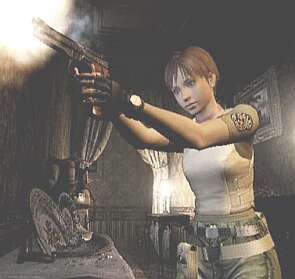 Romero is most – indeed, almost
Romero is most – indeed, almost 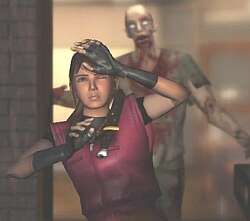 Romero’s problems are, as ever, plot and dialogue. Chris literally stumbles into a secret entrance, yet apparently played there as a child. Chris and Jill get one brief scene, are separated for 30 pages, then come perilously close to having a quickie between kills. Then there are speeches like, “They made you believe you were doing a good thing when it wasn’t good at all. It was evil! The kind of evil that resides in all of us. Makes us greedy, uncaring. The kind of evil that will wipe us out, in the end. Unless we stand up against it.”
Romero’s problems are, as ever, plot and dialogue. Chris literally stumbles into a secret entrance, yet apparently played there as a child. Chris and Jill get one brief scene, are separated for 30 pages, then come perilously close to having a quickie between kills. Then there are speeches like, “They made you believe you were doing a good thing when it wasn’t good at all. It was evil! The kind of evil that resides in all of us. Makes us greedy, uncaring. The kind of evil that will wipe us out, in the end. Unless we stand up against it.”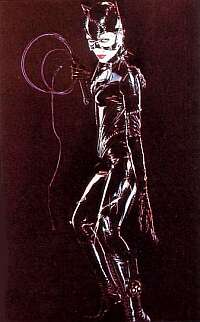 Daniel Waters’ career has been one of ups and downs. For every brilliantly-observed piece of satire, such as Heathers, there has been…well, Hudson Hawk. However, also on his resume is perhaps the best Dark Knight movie yet made, Batman Returns – though, let’s face it, with a supporting cast including Christopher Walken, Michelle Pfeiffer and Danny DeVito, a telephone directory would likely have made compelling viewing.
Daniel Waters’ career has been one of ups and downs. For every brilliantly-observed piece of satire, such as Heathers, there has been…well, Hudson Hawk. However, also on his resume is perhaps the best Dark Knight movie yet made, Batman Returns – though, let’s face it, with a supporting cast including Christopher Walken, Michelle Pfeiffer and Danny DeVito, a telephone directory would likely have made compelling viewing.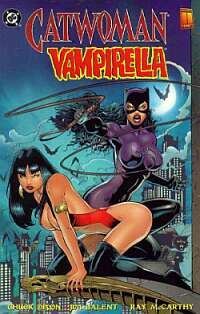 This is, very clearly, a parody of the superhero genre, playing with the conventions of secret identities, powers, merchandising and so on. The part of Spooky, one of the CoG members who is a woman masquerading as a male superhero, looks to have been written for Michelle Yeoh – one move is described as “a famous maneuver of renowned Hong Kong actress Michelle Khan — hint, hint” which puts Waters several years ahead of Hollywood in recognising her talents.
This is, very clearly, a parody of the superhero genre, playing with the conventions of secret identities, powers, merchandising and so on. The part of Spooky, one of the CoG members who is a woman masquerading as a male superhero, looks to have been written for Michelle Yeoh – one move is described as “a famous maneuver of renowned Hong Kong actress Michelle Khan — hint, hint” which puts Waters several years ahead of Hollywood in recognising her talents. Few films had as twisted a path to the screen as Tomb Raider. [For a three-part history of some of the rumours since August 1997, see
Few films had as twisted a path to the screen as Tomb Raider. [For a three-part history of some of the rumours since August 1997, see  Once they enter the El Dorado complexes, the script reads like a description of levels from the game, with levers to pull, gaps to jump, tunnels to swim through, and keys to rooms located in other places. It’s hard to see how this could have been brought to the screen without feeling like you were watching someone playing the game. In addition, the trick used to locate an entrance is a painfully direct steal from the textbook of Dr. Jones – as is the massive, rolling boulder that forms one of the traps inside.
Once they enter the El Dorado complexes, the script reads like a description of levels from the game, with levers to pull, gaps to jump, tunnels to swim through, and keys to rooms located in other places. It’s hard to see how this could have been brought to the screen without feeling like you were watching someone playing the game. In addition, the trick used to locate an entrance is a painfully direct steal from the textbook of Dr. Jones – as is the massive, rolling boulder that forms one of the traps inside.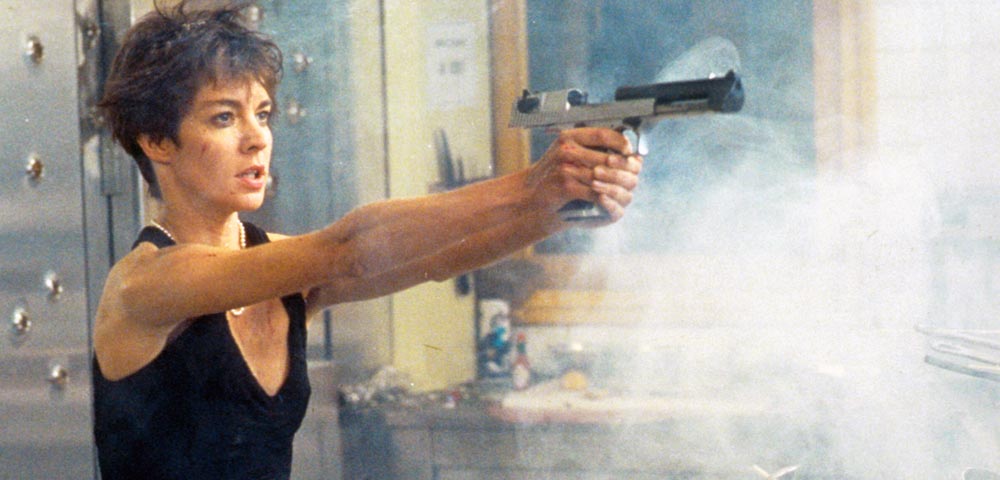
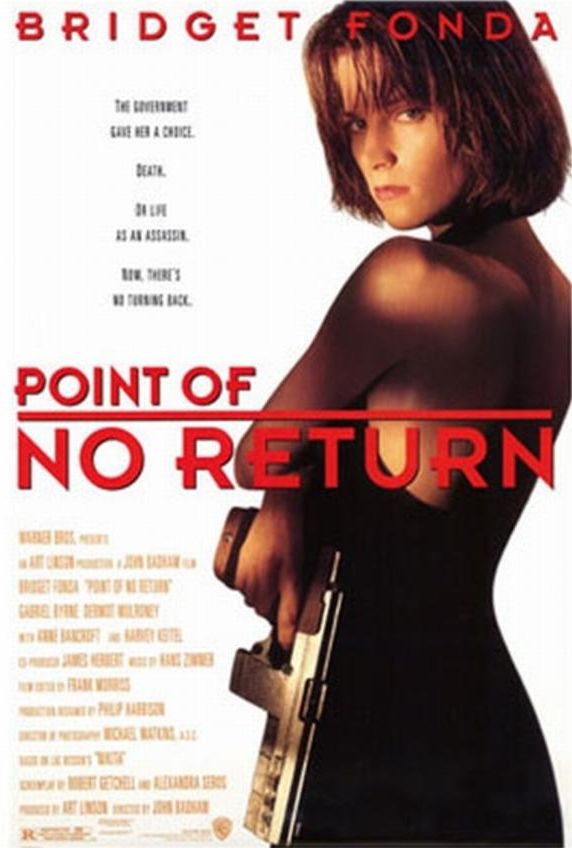
 ★★★
★★★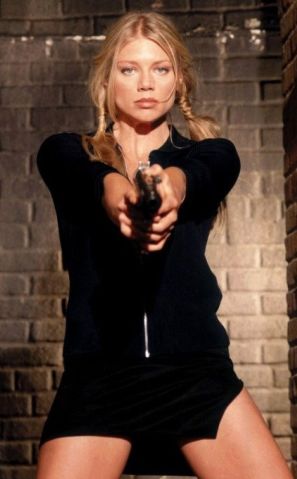 The other chance is that Section One, their version of Division, is not malicious – at least not in the same way. It’s certainly a heartless organization, which is utterly ruthless, and prepared to dispose of anyone who may interfere with their actions, but it’s more an awareness that when you’re dealing with terrorists, organized crime or other threats to the country and world, you can’t be unwilling to get your hands dirty. It leads to a significant bleaker overall tone, and is amazingly prophetic, given this was screened well before 9/11 led to this attitude become a necessary part of national security. Early on, it’s established that you can never trust Section heads Operation (Glazer) and Madeleine (Watson, who was also part of the remake, playing Senator Pierce – her given name there was also Madeleine), to the extent that their deceit becomes almost a cliché.
The other chance is that Section One, their version of Division, is not malicious – at least not in the same way. It’s certainly a heartless organization, which is utterly ruthless, and prepared to dispose of anyone who may interfere with their actions, but it’s more an awareness that when you’re dealing with terrorists, organized crime or other threats to the country and world, you can’t be unwilling to get your hands dirty. It leads to a significant bleaker overall tone, and is amazingly prophetic, given this was screened well before 9/11 led to this attitude become a necessary part of national security. Early on, it’s established that you can never trust Section heads Operation (Glazer) and Madeleine (Watson, who was also part of the remake, playing Senator Pierce – her given name there was also Madeleine), to the extent that their deceit becomes almost a cliché. On the other hand, apart from the lack of action, the angle I liked least was the relationship between Nikita and her handler/fellow agent, Michael (Dupuis). I’ll come right out and say it: I hate ‘shippers, and storylines that pander to them are nothing more than an irritant to me, especially in shows which I watch for action, where they do little except interfere with the good stuff, in my humble opinion. [We’ve seen this in the new incarnation, where the show has disintegrated from one of the best shows on TV, into little more than Mr. and Mrs. Smith And Friends.] I’m definitely a “noromo”: If I wanted unresolved sexual tension and relationship nonsense, I’d watch daytime soap operas. Right from the first time Nikita and Michael meet, it’s doe-eyed heaven, even though there is obviously little or no honesty, trust and anything else on which a genuine relationship could ever be founded.
On the other hand, apart from the lack of action, the angle I liked least was the relationship between Nikita and her handler/fellow agent, Michael (Dupuis). I’ll come right out and say it: I hate ‘shippers, and storylines that pander to them are nothing more than an irritant to me, especially in shows which I watch for action, where they do little except interfere with the good stuff, in my humble opinion. [We’ve seen this in the new incarnation, where the show has disintegrated from one of the best shows on TV, into little more than Mr. and Mrs. Smith And Friends.] I’m definitely a “noromo”: If I wanted unresolved sexual tension and relationship nonsense, I’d watch daytime soap operas. Right from the first time Nikita and Michael meet, it’s doe-eyed heaven, even though there is obviously little or no honesty, trust and anything else on which a genuine relationship could ever be founded. ★★★★
★★★★ I was reassured by the casting of Maggie Q as the lead, who has a solid action pedigree, both in Hong Kong (Naked Weapon) and the West (Live Free or Die Hard and M-I:3). While its source material was clear, it took a different approach. Instead of telling Nikita’s story from the beginning, with her recruitment into a shadowy semi-official organization and training as an assassin, it starts later, after she has mutinied and left them. Now, she is working to bring down the organization known as Division, its leader, Percy (Berkeley), and his right-hand man, Michael (West), who trained Nikita before she went rogue. Her ‘secret weapon’ is Alex (Fonseca), a new recruit going through training, while acting as Nikita’s mole and feeding her information, allowing her to sabotage and obstruct Division’s missions.
I was reassured by the casting of Maggie Q as the lead, who has a solid action pedigree, both in Hong Kong (Naked Weapon) and the West (Live Free or Die Hard and M-I:3). While its source material was clear, it took a different approach. Instead of telling Nikita’s story from the beginning, with her recruitment into a shadowy semi-official organization and training as an assassin, it starts later, after she has mutinied and left them. Now, she is working to bring down the organization known as Division, its leader, Percy (Berkeley), and his right-hand man, Michael (West), who trained Nikita before she went rogue. Her ‘secret weapon’ is Alex (Fonseca), a new recruit going through training, while acting as Nikita’s mole and feeding her information, allowing her to sabotage and obstruct Division’s missions. They even crammed in nice nods to the original movie and its TV predecessor too, with a dive down a chute to escape, and a cameo from Alberta Watson, one of La Femme Nikita‘s actors, as part of the intelligence committee supposedly in charge of Division. By the time the dust has settled, Nikita was driving off into the sunset with a surprising ally, and Alex was also teamed up in a new way, setting things up nicely for the second series. Whether it was going to get one or not seemed in doubt for a while, as the rating did sag mid-season, dropping the show onto the ‘bubble’. However, it was announced in May that the CW would pick it up for another series, moving the show to Friday nights to play along with Supernatural.
They even crammed in nice nods to the original movie and its TV predecessor too, with a dive down a chute to escape, and a cameo from Alberta Watson, one of La Femme Nikita‘s actors, as part of the intelligence committee supposedly in charge of Division. By the time the dust has settled, Nikita was driving off into the sunset with a surprising ally, and Alex was also teamed up in a new way, setting things up nicely for the second series. Whether it was going to get one or not seemed in doubt for a while, as the rating did sag mid-season, dropping the show onto the ‘bubble’. However, it was announced in May that the CW would pick it up for another series, moving the show to Friday nights to play along with Supernatural.
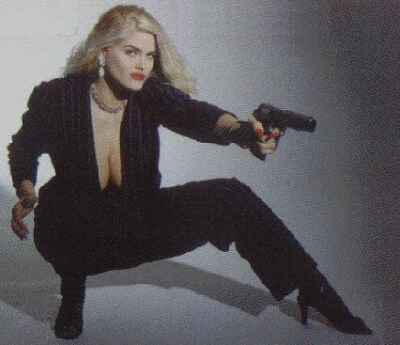 “Twin towers”
“Twin towers”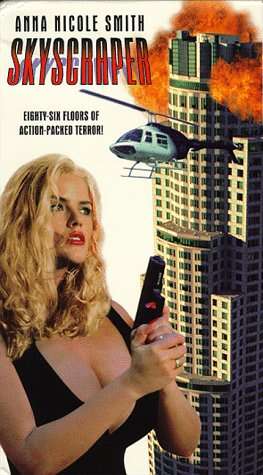 The obvious point of comparison for Smith would be Pamela Anderson, another Playboy playmate who moved into films of doubtful quality, but any such comparison would be unfair. To Anderson, that is, who given the right role, is not actually too bad. With Smith, you get the feeling she simply has no talent, and any character would be a stretch, let alone the Shakespeare-aware, ace helicopter pilot and crackshot she is supposed to portray in this shameless Die Hard clone.
The obvious point of comparison for Smith would be Pamela Anderson, another Playboy playmate who moved into films of doubtful quality, but any such comparison would be unfair. To Anderson, that is, who given the right role, is not actually too bad. With Smith, you get the feeling she simply has no talent, and any character would be a stretch, let alone the Shakespeare-aware, ace helicopter pilot and crackshot she is supposed to portray in this shameless Die Hard clone.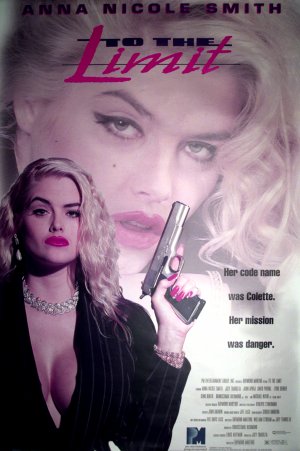
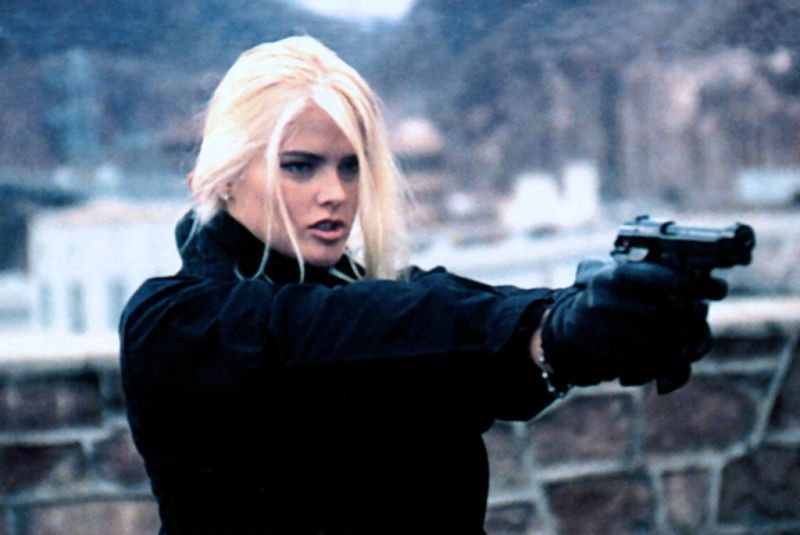
 Okay, her swansong won’t be up there with James Dean’s or Bruce Lee’s, but this does at least sense its own idiocy, rendering the movie somewhat bullet-proof, critically speaking. It’s supposed to be dumb, wildly implausible and hideously over-acted. So condemning it for these flaws is complaining because your hotdog tastes of meat. A trio of shape-shifting aliens land on Earth to protect it from the scum of the universe. Thanks to their first encounter with our culture coming in the shape of a porno mag, they opt for the form of attractive women. Two end up getting jobs as FX/stunt people in Hollywood – a sadly underexplored angle – while the third is…Anna Nicole Smith. Then their nemesis (Laurer, the actress formerly known as Chyna) turns up, taking over the body of a mobster’s wife, and prepares to bring about the end of the world. Can she be stopped?
Okay, her swansong won’t be up there with James Dean’s or Bruce Lee’s, but this does at least sense its own idiocy, rendering the movie somewhat bullet-proof, critically speaking. It’s supposed to be dumb, wildly implausible and hideously over-acted. So condemning it for these flaws is complaining because your hotdog tastes of meat. A trio of shape-shifting aliens land on Earth to protect it from the scum of the universe. Thanks to their first encounter with our culture coming in the shape of a porno mag, they opt for the form of attractive women. Two end up getting jobs as FX/stunt people in Hollywood – a sadly underexplored angle – while the third is…Anna Nicole Smith. Then their nemesis (Laurer, the actress formerly known as Chyna) turns up, taking over the body of a mobster’s wife, and prepares to bring about the end of the world. Can she be stopped? There’s no doubt this film is, if not cashing in on her death, certainly shrugging its shoulders and taking advantage of an unfortunate situation. I don’t really blame them for that, even if anyone looking for skin will be wasting their time here. In sharp contrast to her previous, ah, body of work, AN’s clothes remain on; as exploitation goes, this is tame and restrained. And that may be the main problem: a failure by the makers to decide which way to go. SF/action or all-out comedy? There’s enough of each to suggest, with greater commitment, either might have worked better. Instead, it comes off as somewhat lukewarm – can’t say we were ever bored, yet I can’t say I was ever more than mildly amused.
There’s no doubt this film is, if not cashing in on her death, certainly shrugging its shoulders and taking advantage of an unfortunate situation. I don’t really blame them for that, even if anyone looking for skin will be wasting their time here. In sharp contrast to her previous, ah, body of work, AN’s clothes remain on; as exploitation goes, this is tame and restrained. And that may be the main problem: a failure by the makers to decide which way to go. SF/action or all-out comedy? There’s enough of each to suggest, with greater commitment, either might have worked better. Instead, it comes off as somewhat lukewarm – can’t say we were ever bored, yet I can’t say I was ever more than mildly amused.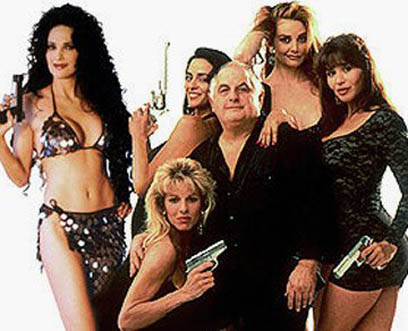 It’s perhaps no surprise that Sidaris gravitated towards the action genre, having for many years been a TV sports producer, winning seven Emmys in the process. He also was responsible for the football scenes in M.A.S.H., though director Robertn Altman stiffed him out of credit for that, to Sidaris’s lasting disdain; more than 30 years later,
It’s perhaps no surprise that Sidaris gravitated towards the action genre, having for many years been a TV sports producer, winning seven Emmys in the process. He also was responsible for the football scenes in M.A.S.H., though director Robertn Altman stiffed him out of credit for that, to Sidaris’s lasting disdain; more than 30 years later, 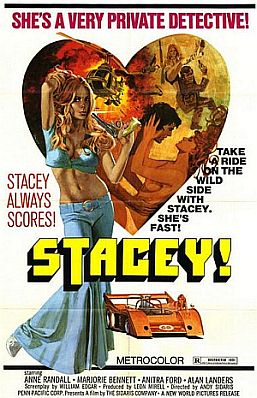 While this wasn’t Sidaris’s first feature – he’d done The Racing Scene, with James Garner in 1967 – this was likely the prototype of the BB&B (Blood, Bullets & Babes) flicks that would become his trademark. If all the elements do not quite mesh in the way they eventually would, they are all present, mostly in the shape of Anne Randall, a former Playboy playmate who plays private investigator Stacey, and looks a bit like Heather Graham.
While this wasn’t Sidaris’s first feature – he’d done The Racing Scene, with James Garner in 1967 – this was likely the prototype of the BB&B (Blood, Bullets & Babes) flicks that would become his trademark. If all the elements do not quite mesh in the way they eventually would, they are all present, mostly in the shape of Anne Randall, a former Playboy playmate who plays private investigator Stacey, and looks a bit like Heather Graham. Female action fans would be well advised to give this a wide berth. Actually, so should everyone else, unless they’re fans of crass sexism, extremely clunky exposition and hideous country & western. Cody Abilene (Hinton) is a PI hired by Countess Luciana (Danning) to look into the export of illegal computer technology to the Russians, centred on the home of Lady Lillian Chamberlain. Who is responsible? Oversexed chauffeur Shane? Daughters Lisa and Anita? Or the maid, Marion? [groan…]
Female action fans would be well advised to give this a wide berth. Actually, so should everyone else, unless they’re fans of crass sexism, extremely clunky exposition and hideous country & western. Cody Abilene (Hinton) is a PI hired by Countess Luciana (Danning) to look into the export of illegal computer technology to the Russians, centred on the home of Lady Lillian Chamberlain. Who is responsible? Oversexed chauffeur Shane? Daughters Lisa and Anita? Or the maid, Marion? [groan…] Also known as Hard Titties in Hawaii – at least in this house – it’s a big step forward as far as the evolution of Sidaris’ work goes. After the flailing around that was Malibu Express, he’s now firmly settled on Hawaii as a location, and jiggly action/adventure as the genre. However, he still unfortunately seems to want to cram lame comedy in there, such as clunky references to his previous films, while many of the actors appear not to have been chosen for their thespian ability – to their credit, Speir and Carlton aren’t particularly the worst offenders.
Also known as Hard Titties in Hawaii – at least in this house – it’s a big step forward as far as the evolution of Sidaris’ work goes. After the flailing around that was Malibu Express, he’s now firmly settled on Hawaii as a location, and jiggly action/adventure as the genre. However, he still unfortunately seems to want to cram lame comedy in there, such as clunky references to his previous films, while many of the actors appear not to have been chosen for their thespian ability – to their credit, Speir and Carlton aren’t particularly the worst offenders.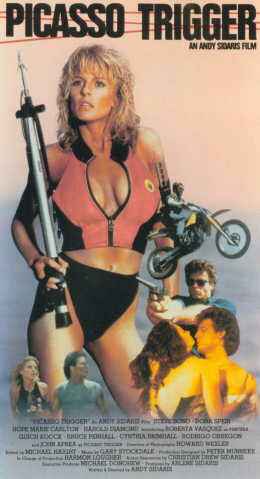 Salazar (Aprea) is a famously devious assassin who gets shot by a sniper just after he donates a painting (of the emblematic ‘Picasso triggerfish’) to a Parisian art gallery. This sparks a series of lethal attacks on undercover federal spy teams who are Salazar’s enemies. But are the various bad-guys, who use all manner of tricks to eliminate government agents, all working for a criminal mastermind?
Salazar (Aprea) is a famously devious assassin who gets shot by a sniper just after he donates a painting (of the emblematic ‘Picasso triggerfish’) to a Parisian art gallery. This sparks a series of lethal attacks on undercover federal spy teams who are Salazar’s enemies. But are the various bad-guys, who use all manner of tricks to eliminate government agents, all working for a criminal mastermind? This one doesn’t really get going until the second half, when the search for a lost hoard of Japanese wartime gold, looted from the Philippines, leads to a remote island. There are CIA agents, revolutionaries, a left-behind Japanese soldier and, of course, our lovely heroines Dona and Taryn (Speir and Carlton) who end up there after their plane crashes in a storm. Or rather, “storm” – you can get a cheap laugh by seeing the bright blue skies as they land in the middle of a clearly hose-supplied downpour. Sidaris probably felt the need to justify their otherwise implausible strip-tease shortly after departure. Or do FAA regulation stipulate pilots must remove their tops in emergencies? Two take-offs for the price of one…
This one doesn’t really get going until the second half, when the search for a lost hoard of Japanese wartime gold, looted from the Philippines, leads to a remote island. There are CIA agents, revolutionaries, a left-behind Japanese soldier and, of course, our lovely heroines Dona and Taryn (Speir and Carlton) who end up there after their plane crashes in a storm. Or rather, “storm” – you can get a cheap laugh by seeing the bright blue skies as they land in the middle of a clearly hose-supplied downpour. Sidaris probably felt the need to justify their otherwise implausible strip-tease shortly after departure. Or do FAA regulation stipulate pilots must remove their tops in emergencies? Two take-offs for the price of one… Two federal agents (Speir and Vasquez) are hot on the trail of South American gangster Degas (Estrada), after one of their friends is shot during one of his hits – but perhaps that’s really what he wants? Zipping around from Hawaii to Arizona to Las Vegas, this was the first Sidaris movie I saw, and was probably better than I expected. While obviously not shot on an unlimited budget, most of the deficiencies are made up for in energy and a host of interesting characters.
Two federal agents (Speir and Vasquez) are hot on the trail of South American gangster Degas (Estrada), after one of their friends is shot during one of his hits – but perhaps that’s really what he wants? Zipping around from Hawaii to Arizona to Las Vegas, this was the first Sidaris movie I saw, and was probably better than I expected. While obviously not shot on an unlimited budget, most of the deficiencies are made up for in energy and a host of interesting characters.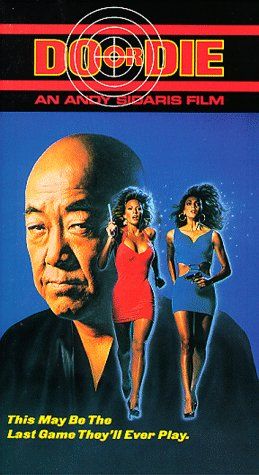 In a filmography not exactly noted for thought-out plots, this maybe counts as one of the thinnest. Donna (Speir) and Nicole (Vasquez) are targeted by death for Kane (Morita) for their interference in his illegal business ventures. But rather than simply bumping them off, as any sane criminal mastermind would do, he informs them of his intentions to send six separate pairs of assassins after them, beginning the next morning. Our pair of federal lovelies head out of Hawaii, little knowing that a tracker has been placed on them, allowing Kane’s to follow them, while their master sits in his apartment and follows the progress of his “game” on a computer display resembling a bad TRS-80 game [younger readers can Google “TRS-80” if they need specifics], as they proceed from Las Vegas to Louisiana, with a motley crew of associated agents in tow, including infamous Meyer model, Pandora Peaks. No prizes for guessing her role.
In a filmography not exactly noted for thought-out plots, this maybe counts as one of the thinnest. Donna (Speir) and Nicole (Vasquez) are targeted by death for Kane (Morita) for their interference in his illegal business ventures. But rather than simply bumping them off, as any sane criminal mastermind would do, he informs them of his intentions to send six separate pairs of assassins after them, beginning the next morning. Our pair of federal lovelies head out of Hawaii, little knowing that a tracker has been placed on them, allowing Kane’s to follow them, while their master sits in his apartment and follows the progress of his “game” on a computer display resembling a bad TRS-80 game [younger readers can Google “TRS-80” if they need specifics], as they proceed from Las Vegas to Louisiana, with a motley crew of associated agents in tow, including infamous Meyer model, Pandora Peaks. No prizes for guessing her role. It’s very easy to mock a film, when the lesbian necking starts before the meaningful dialogue, and is immediately followed by a musical number where Cynthia Brimhall channels the spirit of Jimmy Buffett. Yet the endearing loopiness on display here did a better job of keeping my interest throughout than many movies made with far larger budgets. The plot centers on a jade Buddha, containing a nuclear trigger, which starts off in the hands of Kane (Moore), only for it to be swiped by an undercover agent: she is gunned down, but passes it to Donna (Speir), who has to try and keep it out of Kane’s clutches. However, an unfortunate bout of amnesia leaves her partner Nicole (Vazquez) and the other agents trying to find her first.
It’s very easy to mock a film, when the lesbian necking starts before the meaningful dialogue, and is immediately followed by a musical number where Cynthia Brimhall channels the spirit of Jimmy Buffett. Yet the endearing loopiness on display here did a better job of keeping my interest throughout than many movies made with far larger budgets. The plot centers on a jade Buddha, containing a nuclear trigger, which starts off in the hands of Kane (Moore), only for it to be swiped by an undercover agent: she is gunned down, but passes it to Donna (Speir), who has to try and keep it out of Kane’s clutches. However, an unfortunate bout of amnesia leaves her partner Nicole (Vazquez) and the other agents trying to find her first.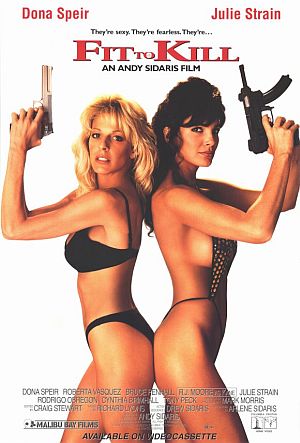 Hang on, two movies ago, criminal mastermind Kane was Japanese – now, he’s the son of a Nazi officer who went on the run after the war with a diamond stolen from the Russians? I know I’m watching these all of our order, but still… They even refer to a pendant with a tracking device in it, given to the Japanese version of Kane, even though Moore now appears to be channeling Julian Sands, not Pat Morita. I’m so confused. Still, logic, continuity and coherence are not really the point here, are they?
Hang on, two movies ago, criminal mastermind Kane was Japanese – now, he’s the son of a Nazi officer who went on the run after the war with a diamond stolen from the Russians? I know I’m watching these all of our order, but still… They even refer to a pendant with a tracking device in it, given to the Japanese version of Kane, even though Moore now appears to be channeling Julian Sands, not Pat Morita. I’m so confused. Still, logic, continuity and coherence are not really the point here, are they? While containing many of the same elements as usual e.g. boobs and bombs, this does at least throw in a new angle, in the shape of some Confederate gold buried in the woods since the Civil War – I can only presume Sidaris must have befriended a Civil War re-enactment battalion. Out enjoying a bit of off-road action, amusingly-named federal agent Becky Midnite (Simpson) and her two co-workers stumble across a diary written by one of the soldiers transporting the gold. However, their plans to search for the treasure are disrupted by efforts to kill them, courtesy of mob boss Santiago. He is upset after they shut down his operation that involved shipping drugs in hollowed-out watermelons. Fed up with the ineptness of his minions, he hires even more amusingly-named assassin Jewel Panther (Strain) to carry out what they have failed to do.
While containing many of the same elements as usual e.g. boobs and bombs, this does at least throw in a new angle, in the shape of some Confederate gold buried in the woods since the Civil War – I can only presume Sidaris must have befriended a Civil War re-enactment battalion. Out enjoying a bit of off-road action, amusingly-named federal agent Becky Midnite (Simpson) and her two co-workers stumble across a diary written by one of the soldiers transporting the gold. However, their plans to search for the treasure are disrupted by efforts to kill them, courtesy of mob boss Santiago. He is upset after they shut down his operation that involved shipping drugs in hollowed-out watermelons. Fed up with the ineptness of his minions, he hires even more amusingly-named assassin Jewel Panther (Strain) to carry out what they have failed to do.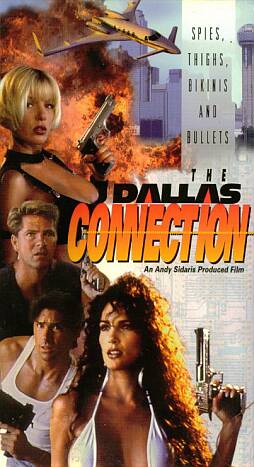 Among Sidaris fans, I imagine arguments over whether this one counts, much like the Never Say Never Again debate among 007 lovers. For this was directed not by Andy, but son Drew; Dad and Mom were merely executive producers. However, the content is much the same, though (and I can’t believe I’m writing this) Drew lacks the subtle touch of Sidaris Sr. Case in point: the very first shot is of the Eiffel Tower, establishing that this is Paris. However, the point is then rammed home with footage of the Arc De Triomphe, Place de la Concorde and Notre Dame. Similarly before the ‘South African’ scenes; we get so much wildlife footage, it feels more like the Discovery Channel.
Among Sidaris fans, I imagine arguments over whether this one counts, much like the Never Say Never Again debate among 007 lovers. For this was directed not by Andy, but son Drew; Dad and Mom were merely executive producers. However, the content is much the same, though (and I can’t believe I’m writing this) Drew lacks the subtle touch of Sidaris Sr. Case in point: the very first shot is of the Eiffel Tower, establishing that this is Paris. However, the point is then rammed home with footage of the Arc De Triomphe, Place de la Concorde and Notre Dame. Similarly before the ‘South African’ scenes; we get so much wildlife footage, it feels more like the Discovery Channel.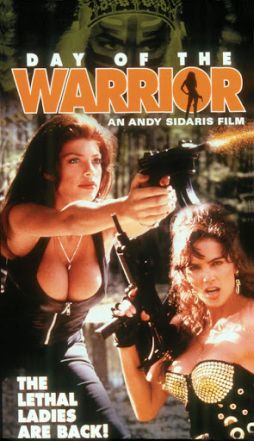 Andy was back on the helm for this one, but appears to have opted to go beyond subtle self-referential digs into full-blown camp, and I tend to think this takes away from the overall experience. The intent is clear when we are brought into the office of Willow Black, the head of L.E.T.H.A.L. (The Legion to Ensure Total Harmony and Law), and find her exercising on a treadmill in an outfit more suited for an exotic dancer. Which makes sense, because if you’re a female agent of LETHAL, you can bet you’ll be going undercover as a stripper or a porn actress – not quite the empowering government job one might expect. It also appears that breast enlargement surgery is required for all such operatives.
Andy was back on the helm for this one, but appears to have opted to go beyond subtle self-referential digs into full-blown camp, and I tend to think this takes away from the overall experience. The intent is clear when we are brought into the office of Willow Black, the head of L.E.T.H.A.L. (The Legion to Ensure Total Harmony and Law), and find her exercising on a treadmill in an outfit more suited for an exotic dancer. Which makes sense, because if you’re a female agent of LETHAL, you can bet you’ll be going undercover as a stripper or a porn actress – not quite the empowering government job one might expect. It also appears that breast enlargement surgery is required for all such operatives.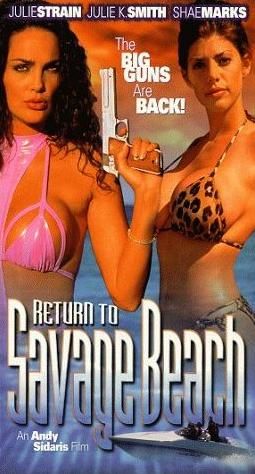 This was Sidaris’s last film, and after the disappointment of Warrior, it’s nice to see him return to a more straightforward approach, with little of the post-modernity attempted there. It is largely a sequel to Savage Beach, with a raid on the LETHAL offices puzzling Willow (Strain) and her agents, because the only thing accessed was the files on that case, which have long been closed. However, it turns out the villain there, Rodrigo (Obregon) did not die in a fiery, explosive-tipped crossbow bolt explosion as thought, and now sports a nifty mask, apparently lifted from a production of Phantom of the Opera. He sends his blonde minion in her submarine(!), along with his ninjas(!!), back to the island to claim a priceless Golden Buddha buried there, and it’s up to Cobra (Smith), Tiger (Marks) and their himbo colleagues, to stop him.
This was Sidaris’s last film, and after the disappointment of Warrior, it’s nice to see him return to a more straightforward approach, with little of the post-modernity attempted there. It is largely a sequel to Savage Beach, with a raid on the LETHAL offices puzzling Willow (Strain) and her agents, because the only thing accessed was the files on that case, which have long been closed. However, it turns out the villain there, Rodrigo (Obregon) did not die in a fiery, explosive-tipped crossbow bolt explosion as thought, and now sports a nifty mask, apparently lifted from a production of Phantom of the Opera. He sends his blonde minion in her submarine(!), along with his ninjas(!!), back to the island to claim a priceless Golden Buddha buried there, and it’s up to Cobra (Smith), Tiger (Marks) and their himbo colleagues, to stop him.
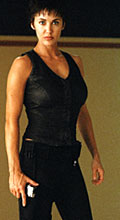 The setting is the near-future, when corporations have taken over, and even the FBI is now the Incorporated Bureau of Investigations. The star is Bobbie Phillips, who plays Kam, a creation of the IBI. She was made as a special agent, with mostly human DNA, but also traces of cougar, falcon and chameleon. This gives her an interesting power: she can make her skin match her surroundings almost perfectly. Fortunately – or not – this skill is also possessed by her clothes, which is a bit of a plot clunker, designed to avoid both the traditional Invisible Man-styled floating shirts, and gratuitous nudity.
The setting is the near-future, when corporations have taken over, and even the FBI is now the Incorporated Bureau of Investigations. The star is Bobbie Phillips, who plays Kam, a creation of the IBI. She was made as a special agent, with mostly human DNA, but also traces of cougar, falcon and chameleon. This gives her an interesting power: she can make her skin match her surroundings almost perfectly. Fortunately – or not – this skill is also possessed by her clothes, which is a bit of a plot clunker, designed to avoid both the traditional Invisible Man-styled floating shirts, and gratuitous nudity.
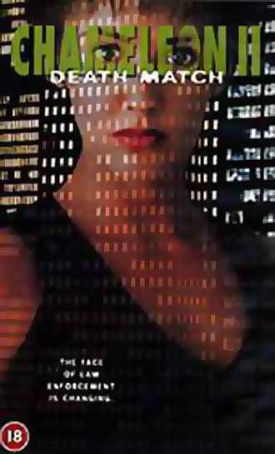
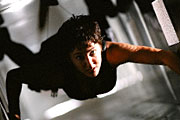 There’s one sequence with Kam scurrying, lightning-fast, up a ventilation shaft (left) and a rather good brawl involving her that made me sit up and pay attention, offering hope for the rest of the movie. It’s a red herring. The last twenty minutes finally stop slavishly cloning Bruce Willis, with the villain not being who you’d expect (though if you think about who played the bad guys in the Die Hard trilogy, it’s not hard to work out). One good twist at the end is Kam recovering the “loot” and using it for her own ends, which extends her nicely amoral attitude. There’s also a nod to Kam’s not-entirely human origins, and how they affect her emotions, which would be a good avenue for future exploration.
There’s one sequence with Kam scurrying, lightning-fast, up a ventilation shaft (left) and a rather good brawl involving her that made me sit up and pay attention, offering hope for the rest of the movie. It’s a red herring. The last twenty minutes finally stop slavishly cloning Bruce Willis, with the villain not being who you’d expect (though if you think about who played the bad guys in the Die Hard trilogy, it’s not hard to work out). One good twist at the end is Kam recovering the “loot” and using it for her own ends, which extends her nicely amoral attitude. There’s also a nod to Kam’s not-entirely human origins, and how they affect her emotions, which would be a good avenue for future exploration.
 I imagine no-one genuinely doubts the answer, but this adds a whole new plot twist, especially as the last time the Mongoose activated his weapon, its impact was pretty heavy. What happens when it’s used here is never really shown, and there is some scientific handwaving about the black hole absorbing all the energy, but it would be gratifying to think that it became necessary to destroy the city in order to save it. Not least because Cameron’s Dark Angel
I imagine no-one genuinely doubts the answer, but this adds a whole new plot twist, especially as the last time the Mongoose activated his weapon, its impact was pretty heavy. What happens when it’s used here is never really shown, and there is some scientific handwaving about the black hole absorbing all the energy, but it would be gratifying to think that it became necessary to destroy the city in order to save it. Not least because Cameron’s Dark Angel 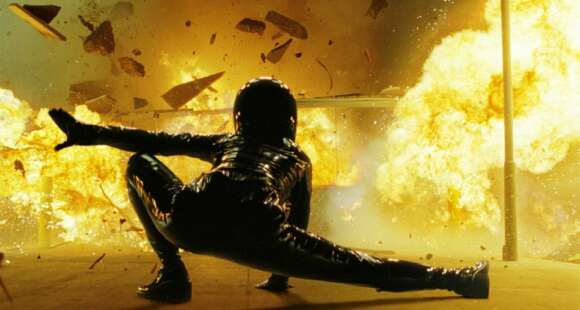 Police Officer: “I think we can handle one little girl. I sent two units. They’re bringing her down now.”
Police Officer: “I think we can handle one little girl. I sent two units. They’re bringing her down now.”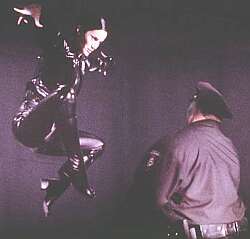 Few movies have been so influential as The Matrix, with its seamless combination of elements from Hong Kong action, anime, and science-fiction, to which the Wachowski brothers added a sprinkling of semi-original thoughts and some very cool sunglasses. One of the key pieces in the jigsaw is Trinity, played by Carrie-Anne Moss – normally, supporting characters fall outside our realm here, but Trinity transcends the usual bounds imposed on such roles. Along with Lara Croft, she has become one of the most important action heroines of the past decade.
Few movies have been so influential as The Matrix, with its seamless combination of elements from Hong Kong action, anime, and science-fiction, to which the Wachowski brothers added a sprinkling of semi-original thoughts and some very cool sunglasses. One of the key pieces in the jigsaw is Trinity, played by Carrie-Anne Moss – normally, supporting characters fall outside our realm here, but Trinity transcends the usual bounds imposed on such roles. Along with Lara Croft, she has become one of the most important action heroines of the past decade.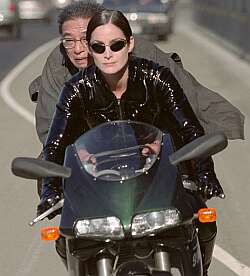 However, she is still more than capable of independent action, such as when she, Morpheus and Neo seek the Keymaker, and are led to him by Persephone. This leads to a battle, first against the Twins, two dreadlocked, white brothers who can pop in and out of physical existence at will. Then, as if this wasn’t enought, there’s the highway chase, where Trinity whizzes
However, she is still more than capable of independent action, such as when she, Morpheus and Neo seek the Keymaker, and are led to him by Persephone. This leads to a battle, first against the Twins, two dreadlocked, white brothers who can pop in and out of physical existence at will. Then, as if this wasn’t enought, there’s the highway chase, where Trinity whizzes  Trinity’s feminine side does show through occasionally, however, most obviously in the nurturing way she initially cares for Neo. She brings him food, causing the traitorous Cypher to comment, “I don’t remember you ever bringing me dinner.” Trinity just rolls her eyes, but Cypher’s jealousy is perhaps a factor in pushing him over the edge into treachery and an alliance with the Agents.
Trinity’s feminine side does show through occasionally, however, most obviously in the nurturing way she initially cares for Neo. She brings him food, causing the traitorous Cypher to comment, “I don’t remember you ever bringing me dinner.” Trinity just rolls her eyes, but Cypher’s jealousy is perhaps a factor in pushing him over the edge into treachery and an alliance with the Agents.